In Japan, which is an earthquake-prone country, the safety of buildings is vital for the continuity and quick recovery of our social and economic activities after major earthquakes. Professor Shoichi Kishiki at the Institute of Innovative Research, Tokyo Institute of Technology is focusing on the safety of the skyscrapers in major cities, where core functions of the society are concentrated, and is taking the challenge of building a system that safeguard the peace of mind of people who gather there not only in their everyday life but also during disasters.
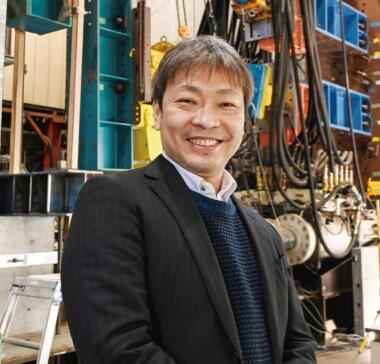
Institute of Innovative Research, Tokyo Institute of Technology
Professor
OPERA Consortium Manager since 2020
The size effect of structural members
Performance analysis by full-scale experiments
It has been ten years since the great Touhoku earthquake in Japan. Taking advantage of our experience of the earthquake disasters, initiatives are being carried out in a variety of fields, from clarifying the earthquake mechanisms to reviewing the evacuation plans of local governments, to realize a safer and more secure society. In the construction industry, earthquake-resistant building technologies are being developed and gradually popularized to protect buildings from earthquake shaking (Fig. 1).
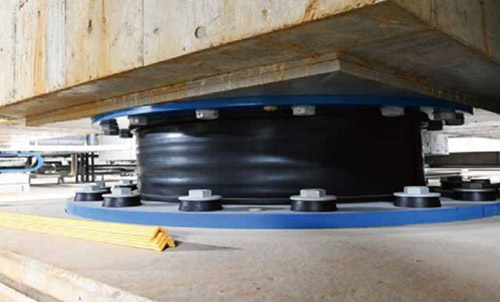
Meanwhile, skyscrapers have been built one after another in recent years and mainly in cities. Skyscrapers over 100 meters tall can accommodate the population of a town and are used for all kinds of purposes including commercial facilities, residences, offices, and universities. We can even say that they are pillars of our society and the economy.
If a city in which these skyscrapers stand next to each other was to be struck by a huge earthquake and these buildings were damaged, the effects would be immeasurable. Professor Shoichi Kishiki of the Institute of Innovative Research, Tokyo Institute of Technology has taken on the challenge of engineering development in the OPERA Consortium for Socio-Functional Continuity Technology (SOFTech), aiming to allow the immediate occupancy of skyscrapers even after a huge earthquake.
Generally, the seismic performance of buildings is tested by imposing simulated earthquake actions on structural members such as columns and beams. Nevertheless, there is no testing facility in Japan that can test the seismic performance of full-scale structural members of mega-structures such as skyscrapers and long-span bridges. Instead, reduced-scale test specimens that can be placed on existing testing equipment are usually used to carry out experiments. Such experiments on scaled specimens present a good and effective evaluation method only if the differences in the physical properties of specimens of different sizes are negligible.
At present, however, we can only assume a variety of scale effects, and predict whether the structure will be safe based on calculations. As a result, multiple additional safety measures are necessary, resulting in increased construction costs. "If we have a huge facility capable of testing the seismic performance of full-scale specimens, adequate evaluations would be possible. But we need funds for the construction of such facilities. We have to make more people understand the need for a huge testing facility," says Prof. Kishiki.
Against this background, to confirm the extent of the scale effect on structural members, Prof. Kishiki and his team explored how much force and/or deformation it takes to cause failure in full-size structural members with differently sized steel frames and welding defects by applying force on them (Fig. 2). Having confirmed a clear scale effect regarding the amount of deformation needed to break the joints of a structural member, many of the engineers who witnessed the experiment reconfirmed the importance of carrying out experiments on full-size members. "Laminated rubber bearings, a type of base isolation device, are made by layering steel plates and rubber, but the larger they are, the harder it is to make a lot of materials that are joined together uniformly and without any faults," says Prof. Kishiki, pointing out an issue concerning building members for huge structures. In addition, the normal width for a single weld is 3-4 mm, so when attempting to create a miniature that is exactly one quarter of the size, the welding must be under 1 mm in width--and such minute welding is impossible.
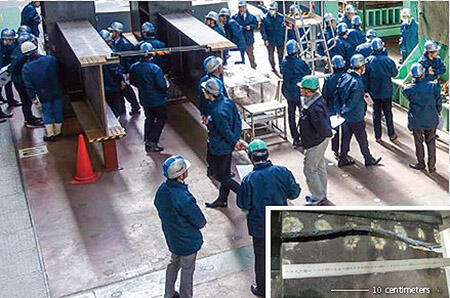
Moreover, if we attempt to create reduced-scale test models of reinforced concrete structures, we must reduce the size of the sand and gravel mixed into the cement by an accurate ratio, which is also impossible in reality. Since there are limits to any estimations of seismic performance based on experiments that use reduced-scale test specimens, Prof. Kishiki and his colleagues intend to encourage relevant institutions to determine the establishment of a large testing facility that enables them to accurately evaluate the seismic performance of full-scale structural members.
Evaluation methods for non-structural components needed
Carrying out experiments with sensors
If the inside of a skyscraper is damaged, it becomes difficult to keep occupying the building. In fact, there are many examples of buildings that were evacuated due to the damage to non-structural components such as walls and ceilings, even if there was no major damage to the structural components.
All components in a building are generally classified as structural components such as columns and beams, and non-structural components such as ceilings and walls that separate rooms. After the Touhoku earthquake in Japan, research on seismic performance was focused on structural components. "If we do not appropriately evaluate and improve the seismic performance of non-structural components, we will not be able to make buildings a safe place for people to stay during a disaster," says Prof. Kishiki.
Until now, the seismic performance of non-structural components has not been considered as carefully as that of structural components. It is not clear as to what we should measure and how we should measure it when it comes to the safety check of nonstructural components. Therefore, SOFTech prepared models of non-structural walls and steel frames that minic actual buildings and carried out experiments that imposed simulated earthquake actions on them until they were damaged (Fig. 3). A large number of sensors that measure the warping of the runners and shaking of the members were installed in the non-structural walls. The aim was to find out how the shaking of an earthquake travels through the walls and causes damage.
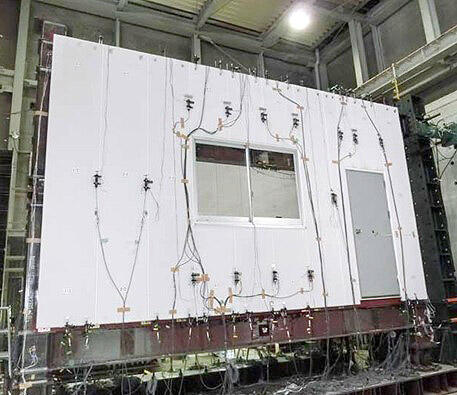
If a method of evaluating the seismic performance of non-structural components is established by repeated experiments, it will enable us to design and construct safer buildings. Moreover, if continuous monitoring of a building as a whole becomes feasible, users of the building will be able to judge on the spot whether they should evacuate the building in an emergency, or whether they can stay. There is a tendency for preparation to be put on the back-burner when it comes to a natural disaster, which can occur any time but the exact time cannot be determined exactly. Therefore, the research team is exploring a system that is operatable under normal circumstances--for example, a system that notifies people when maintenance is needed or equipment is malfunctioning.
Surveys of the damaged buildings in the Kumamoto Earthquakes
"Occupiable if retrofitted" but demolished
The catalysts that turned Prof. Kishiki's attention to the safety of the non-structural components were the 2011 Touhoku earthquake and the 2016 Kumamoto earthquakes in Japan. Prof. Kishiki travelled around the affected areas one month after the Touhoku earthquake, carrying out surveys of the damage to the structural components of buildings. The ceiling of a school gymnasium in Miyagi Prefecture had fallen down and was strewn across the floor (Fig. 4). The teachers of the school asked Prof. Kishiki if they could continue to use the gymnasium. "I didn't know how to answer the question. As a specialist in building structures and disaster prevention, I went there only to see how structures were damaged, and I had never paid attention to a building from the viewpoint of whether people can keep on using it safely with the peace of mind." This incident was the trigger for Prof. Kishiki to focus on the development of methods of estimating the damage to buildings from their appearance.

Turning his attention to places where walls and ceilings were damaged and steel frames were exposed, he developed a method to estimate the extent of damage to steel frames by the peeling of the rust-preventive paint. He also noticed that the extent of bending of diagonal braces, which increase the seismic performance by absorbing earthquake energy, can also be used to estimate extent of damage to structural components.
The evaluation methods that he established in this way were applied in the Kumamoto earthquakes. Prof. Kishiki went there to carry out surveys immediately after the earthquakes and evaluated the extent of the damage to the structural members of buildings. When he visited a school, he judged that the building would be occupiable if it was retrofitted. He made this judgement because, although the non-structural walls that separate the classrooms had fallen down, the structure of the building remained completely undamaged. Unfortunately, however, the building was demolished after a few years (Fig. 5).
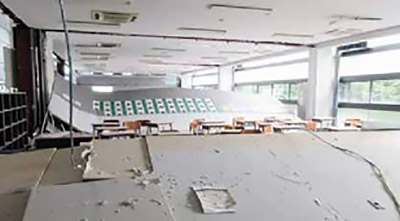
Prof. Kishiki still remembers the words of a person related to the school, which are, "However perfectly we fix the walls, no one wants to have classes in a classroom that reminds them of the earthquake damage." Since then, he has continued to sincerely explore what the occupants of buildings want when it comes to the safety and the peace of mind.
Understanding the mental state of disaster victims:
the path to high-rise buildings where people can take refuge
Prof. Kishiki truly realized from the experience that a building would no longer be used if the occupants are fearful of the building damaged by disasters. In light of this, he took part in a SOFTech project team that considers safety and the peace of mind from a psychological perspective. Associate Professor Mitsue Nagamine at the Institute for Liberal Arts, Tokyo Institute of Technology, is carrying out experiments to evaluate the psychological and physiological states of people who have experienced earthquakes by measuring their pulse rates and perspiration on an "earthquake zabuton" that simulates earthquake shaking when a test subject is sitting in a chair, and a large-scale "earthquake shaking table" that can shake a full-scale room (Fig. 6). If her research can discover how to provide necessary information in a way that reduces anxiety, it is likely that people will be able to stay in safe buildings with the peace of mind.
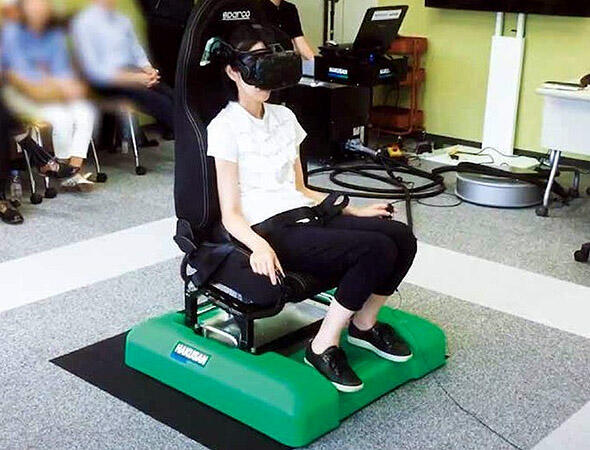
In addition to universities, many companies are participating in SOFTech. The basic knowledge and research outcomes that Prof. Kishiki has clarified are being shared early on with construction companies and material manufacturers involved with SOFTech. "If each company sells products developed based on research outcomes from universities, the number of safe buildings will certainly increase. 'Refuge high-rises' that can take in many people in the case of a huge earthquake will be created"--this is what SOFTech hopes its activities will lead to (Fig. 7).
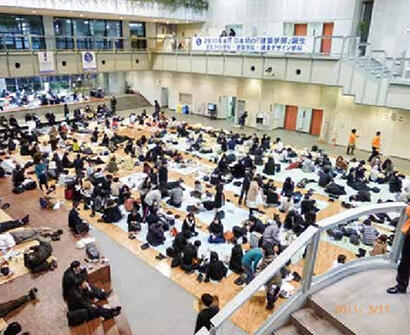
Immediately after a huge earthquake, people loudly discuss the necessity of earthquake-resistant engineering technologies such as base isolation and damping, but the tone tends to weaken as time passes. In fact, according to a survey by the Japan Society of Seismic Isolation, the number of base-isolated buildings increased sharply after large earthquakes such as the Kobe earthquake and the Chuetsu earthquake in Niigata Prefecture, but the trend of increase declined over time. In this year of milestones, Prof. Kishiki is renewing his determination and says, "I want to create a world-leading disaster-resistant society through the combined efforts of industry and academia."




